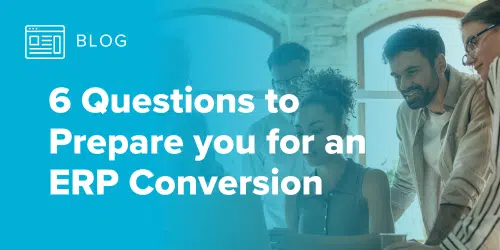6 Questions to Prepare You for an ERP Conversion

As your business grows you may come to a point when your current ERP/accounting system can no longer keep up. Operational inefficiencies, lack of integration capability, and limited reporting are just a few of those signs. If that’s the case, it’s time to consider an upgrade or replacement of existing software solutions, and then plan your ERP conversion.
Once you’ve worked with your ERP (Enterprise Resource Planning) implementation partner to decide which ERP system to choose, it’s essential to have a solid project plan in place for your data conversion approach. With careful planning and execution, your ERP implementation can set your business up for great success.
While moving to a new system can provide more extensive financial reporting and better decision-making capabilities, it’s important to make sure you transition properly. While each conversion is unique, there’s a basic process to follow to ensure a smooth transition of the highest quality.
ERP Data Conversion: A Critical Step in Any ERP Transition
ERP data conversion is an important step in transitioning from an old system to a new ERP system. The process involves taking data from the old system, adding missing data, and transferring it to the new ERP. This not only contributes to a successful ERP implementation project but also presents an opportunity to clean up and rationalize an organization’s data. It entails carefully reviewing legacy data with your project manager, data clensing including removing old customer accounts, and identifying any data inaccuracies. By following this structured approach, organizations can streamline operations and optimize their data management. Here are 6 questions we recommend asking your partner during the planning process:
How much historical data should we convert?
Data conversion is a crucial step in the process of moving to a new ERP system. However, converting large amounts of data can be costly and time-consuming, so it pays to be selective. Talk to your ERP partner about how much data you should bring over and how best to go about it. Here are some points to consider in terms of converting data:
- Most businesses choose not to carry over many years of General Ledger history but bring open transaction balances for Accounts Payable and Accounts Receivable, open sales and purchase orders, and inventory balances.
- Ask your partner how long you’ll be able to access your old system in case you need legacy data.
- Consider the cost and time associated with larger data sets before deciding to migrate it.
Which reports should we migrate to the new system?
Business intelligence is more important than ever so you may be tempted to bring over all your existing reports. However, to avoid duplicate reporting and clutter you’ll want to carry over only those reports related to the current month or that contain other relevant data:
- Analyze existing reports and determine whether they are outdated or irrelevant.
- Consolidate similar reports as much as possible to reduce file clutter.
- Establish a backup plan for any reports or data that you decide not to migrate over.
By migrating only the essential reports your business needs, you’ll make a fresh start with your new system.
Should we change our Chart of Accounts (COA)?
As your company grows you’ll need a COA that can handle more extensive reporting and provide the insights for better decision making. Before migrating to a new system, map the old account to the new account. In order to bring historical transactions to the new account, you may need to map old accounts that you no longer use. Important: don’t map a single old account to multiple new accounts as this can lead to data conversion challenges.
Which reports should we migrate to the new system?
Business intelligence is more important than ever so you may be tempted to bring over all your existing reports. However, to avoid duplicate reporting and clutter you’ll want to carry over only those reports related to the current month or that contain other relevant data:
- Analyze existing reports and determine whether they are outdated or irrelevant.
- Consolidate similar reports as much as possible to reduce file clutter.
- Establish a backup plan for any reports or data that you decide not to migrate over.
By migrating only the essential reports your business needs, you’ll make a fresh start with your new system.
Which software, modules, and features do we want to integrate with our new system?
Many of today’s systems can integrate with websites, sales tax, credit cards and many other important features. Here are a couple of factors to consider when selecting integrations for your ERP system:
- Consider current integrations – Review your current integrations that have been the most useful for you and identify any additional options which could help your team operate more efficiently. Implementing integrations requires minimal configuration and saves you a lot of time!
- Wait to implement new integrations after you go live – It’s important to implement new integrations after the new software is up and running so users have a chance to become familiar with the system first.
What are the new system’s hardware requirements?
Companies that want to streamline their business operations may be wondering what hardware requirements need to be taken into consideration. Whether deploying a cloud-based or on-premise solution, organizations can reduce costs and increase security by removing costly equipment from the equation. Off-premise servers offer greater security and lower costs.
By understanding and evaluating the hardware options available, you can make an informed decision that best suits your business needs.
Should we go live with all companies at once, or one or two at a time?
The decision of whether to go live with all companies at once during an ERP conversion is an important one. Most businesses find it more efficient to implement only one or two companies at a time. That way the team becomes used to the new software before bringing over the remaining companies. Secondly, you’re able to isolate any post-go-live issues by limiting your control group to fewer companies. This will make it easier and quicker to address any issues that may arise as you convert into your new system.
Conclusion
With the above steps, you can ensure a smooth transition as you switch over from your old system to the new one! Overall, be prepared! Make sure you discuss all of these key points with your ERP project manager before converting to a new system.
Our team of ERP specialists can guide you through every step of the conversion process, whether you are migrating from Sage 100, QuickBooks, or any other accounting software. Contact us to learn how we can help you unlock the full potential of your business operations.




